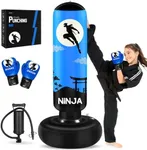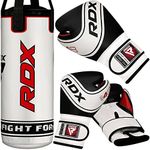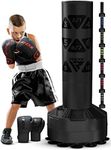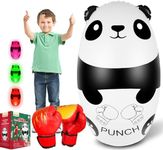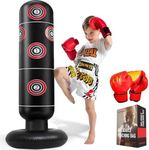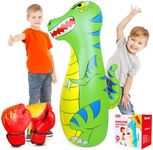Buying Guide for the Best Kids Punching Bags
When choosing a kids' punching bag, it's important to consider factors that ensure safety, durability, and enjoyment for your child. A well-chosen punching bag can help improve your child's physical fitness, coordination, and discipline. To make the best choice, focus on the key specifications that will match your child's age, size, and skill level, as well as the space you have available at home.Size and HeightThe size and height of a kids' punching bag are crucial for ensuring that your child can use it comfortably and effectively. A bag that's too tall or too short can lead to improper technique and frustration. Generally, the punching bag should be about the same height as your child or slightly taller. For younger children, a bag around 3 to 4 feet tall is usually appropriate, while older kids might need a bag that's 4 to 5 feet tall. Consider your child's current height and how much they might grow in the near future when making your choice.
Weight and StabilityThe weight and stability of the punching bag are important for safety and usability. A bag that's too light might tip over easily, while one that's too heavy could be difficult for a child to move or hit effectively. Freestanding bags often have a base that can be filled with water or sand to provide stability. For younger or smaller children, a lighter bag that can be easily moved is ideal, while older or stronger kids might benefit from a heavier bag that offers more resistance.
Material and DurabilityThe material of the punching bag affects its durability and how it feels when hit. Common materials include vinyl, leather, and canvas. Vinyl is often used for kids' bags because it's durable and easy to clean. Leather is more durable and offers a more authentic feel but can be more expensive. Canvas is durable but might be rougher on the hands. Consider how often the bag will be used and whether it will be kept indoors or outdoors when choosing the material. A durable material is important to withstand regular use and ensure longevity.
Filling TypeThe filling of a punching bag affects its weight, feel, and how it absorbs impact. Common fillings include foam, air, and sand. Foam-filled bags are lightweight and provide a softer impact, making them suitable for younger children. Air-filled bags are also light and can be adjusted for firmness, but they might not be as durable. Sand-filled bags are heavier and provide more resistance, which can be beneficial for older kids or those looking to improve strength. Consider your child's age, strength, and the level of resistance they need when choosing the filling type.
Design and FeaturesThe design and features of a kids' punching bag can enhance its appeal and usability. Some bags come with fun designs or characters that can make them more engaging for children. Others might have additional features like adjustable height or interactive elements that provide feedback or track progress. Consider what will keep your child interested and motivated to use the bag regularly. Features that allow the bag to grow with your child, such as adjustable height, can also be a valuable investment.
